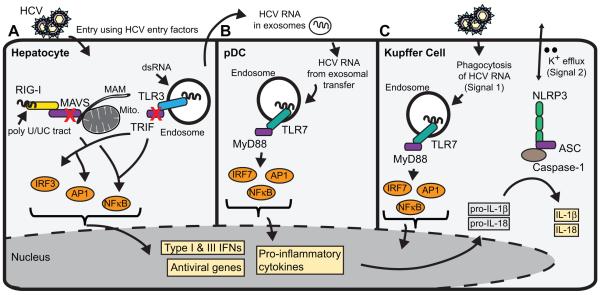Figure 1. Innate immune sensing of HCV.
Hallmarks of HCV infection can be sensed by pattern recognition receptors (PRRs) in a number of cell types within the liver to activate innate immunity. (A) HCV infection in hepatocytes is sensed by RIG-I, which detects the poly U/UC tract present in the 3’end of HCV RNA, and by TLR3, which detects dsRNA replication intermediates or HCV RNA that has been endocytosed from dying cells. These PRRs signal downstream to activate the innate immune response program, including the production of IFNβ, IFNλ, and pro-inflammatory cytokines, which act in an autocrine and paracrine manner to establish the full innate immune response. The red “X” indicates points of regulation of these signaling pathways by the HCV NS3/4A protease. (B) HCV is sensed in plasmacytoid dendritic cells (pDCs) by TLR7-mediated recognition of HCV RNA in the endosome. While pDCs themselves are not productively infected with HCV, the viral RNA is taken up by the pDC following exosomal transfer of viral RNA from productively infected hepatocytes. C) HCV can also be sensed in Kupffer cells, the liver resident macrophages, by the inflammasome signaling complex. Kupffer cells phagocytose HCV RNA (Signal 1) for TLR7-dependent signaling that activates the transcription of the pro-forms of IL-1β and IL-18, while potassium efflux (Signal 2) sensed by NLRP3 drives caspase 1 processing of IL-1β and IL-18 into the mature form for secretion and full activation of the inflammasome.

